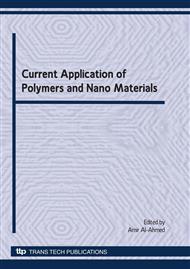p.62
p.75
p.83
p.88
p.116
p.143
p.191
p.208
p.231
Electrical and Proton Conducting Polymer Based Composite Electrodes Incorporating Fuel Cell Catalysts: Screen Printed Systems Analysed Using Hall Measurements
Abstract:
40% Pt on carbon black was used to make various inks. Compositions were altered by changing the organic component (2-propanol vs 1,2-¬propanediol), the liquid to solid ratio, and addition of Fullerenes to alter electronic properties. Inks were printed onto Nafion® or bond paper substrates using a Presco screen printer. The inks rheological properties were thoroughly characterized, and screen printed electrodes were characterized using optical microscopy, and hall measurements. Ink formulation had a major effect on final film morphology, with high water ratio formulations optimum for the Nafion® substrate and low water ratios ideal for bond paper. The final film integrity influenced sheet hall coefficients with p-type carriers dominating inhomogeneous films, and n – type carriers dominating well formed films. However hall mobility did not correlate with film thickness. Rheological studies showed that increasing the solid ratios and changing the solvent increased the viscosity, and the storage modulus (G') of between 84 and 224 and viscoelastic behaviour of inks correlated with good print quality.
Info:
Periodical:
Pages:
116-142
Citation:
Online since:
July 2010
Authors:
Keywords:
Price:
Сopyright:
© 2010 Trans Tech Publications Ltd. All Rights Reserved
Share:
Citation:


